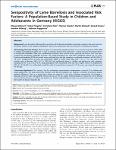Seropositivity of Lyme Borreliosis and Associated Risk Factors: A Population-Based Study in Children and Adolescents in Germany (KiGGS)
Dehnert, Manuel
Fingerle, Volker
Klier, Christiane
Talaska, Thomas
Schlaud, Martin
Krause, Gérard
Wilking, Hendrik
Poggensee, Gabriele
Background: Lyme borreliosis (LB) caused by spirochetes of the Borrelia burgdorferi sensu lato complex is the most common tick-borne disease in the northern hemisphere. Data on the distribution and on risk factors in Germany are sketchy. Methodology/Principal Findings: Blood samples of a nationwide population-based cross-sectional study from 2003–2006 in children and adolescents aged 1 to 17 years in Germany (KiGGS) were analysed (n = 12,614) to assess the seroprevalence of anti-Borrelia antibodies. Data from standardized interviews were used to assess potential risk factors. First, sera were screened for anti-Borrelia antibodies by ELISA. The overall prevalence was 4.8% (95% confidence interval (CI) 4.3–5.4%). Positive and borderline ELISA test results were confirmed by a line blot revealing a combined prevalence of 4.0% (95% CI 3.6–4.5%). Seroprevalence of ELISA was significantly higher in males (odds ratio (OR) = 1.37; CI 1.15–1.63) and in the southern part of Germany (OR = 1.41; CI 1.09–1.83), but significantly lower in children and adolescents with migration background (OR = 0.33; CI 0.24–0.44). Study participants from households with cats had a higher chance of seropositivity (OR = 6.7; CI 5.6–8.0). In a multivariable model the odds of seropositivity increases by 11% for every year of age for boys and 6% for girls. Conclusions/Significance: This survey is the first nationwide, representative seroprevalence survey of LB in children and young adolescents. The study shows that infections with Borrelia burgdorferi are endemic in all parts of Germany despite regional differences. Even at a young age children are exposed to tick bites including seropositivity. Encouraging a thorough check for ticks and promptly removal of ticks are the key public health strategies to reduce the risk of LB and other tick-borne diseases in children and adolescents. Further epidemiological studies are warranted to better understand the burden of disease related to LB.
No license information

